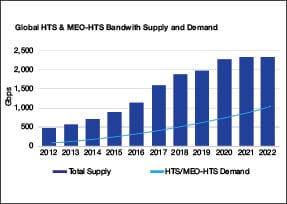Latest News
High Throughput Satellites (HTS) is undoubtedly one of the industry’s hottest topics, no longer confined to a few geographies. As HTS “globalizes,” new questions arise such as how platforms will tend to evolve worldwide; what challenges and opportunities are expected from the emergence of empowering service architectures; and the business models and technologies behind them. With the entire satellite industry gradually transitioning to HTS, these are important debate topics. They affect all stakeholders in the satellite broadband, backhaul and trunking ecosystems including manufacturers, satellite operators, telcos/MNOs, service providers, broadcasters, technology vendors and — most importantly — end users.
Central to the HTS debate is the topic of the business models and, in particular, the pros and cons of the so-called “closed” and “open” network architectures. This is subject to further exploration, debate and clarification during Satellite 2014.
“Closed” HTS Models
The number one goal through this architecture is achieving the lowest possible operational cost per bit on the satellites. This usually pushes HTS architectures toward some degree of vertical integration; such as when the roles of the satellite operator, network infrastructure and IP service are integrated and managed by a single player. Prime examples of this model are HughesNet and ViaSat exede in the U.S. and Eutelsat tooway (KASAT) in Europe.
“Open” HTS Models
This is the model generally favored by traditional wholesale FSS satellite operators and service providers. There have already been use cases including Avanti and Thaicom/Ipstar, but Intelsat will be the global operator spreading use of open HTS B2B architectures worldwide, with the first of EpicNG satellites (IS 29e) scheduled for launch in 2015. EpicNG is truly an evolution of the traditional model of satcom capacity agnostically leased to service providers, which use such capacity as raw material to craft their own differentiated service offerings. Indeed, initial focus is on Ku-band HTS spot beams ensuring a good degree of backward compatibility for traditional service providers and legacy grounds systems.
Note that the terms “closed” and “open” can be misleading simplifications, as these do not truly reflect all aspects of the architectures and business models. IP networks are open by definition, so both architectures can enable a wide range of uses, applications and commercial distribution arrangements.
Naturally, a common denominator across both models, and their variants, is that HTS seeks to achieve a lower cost of bandwidth, relative to traditional FSS, which is key for non-broadcast, bandwidth-demanding applications. Nevertheless, what differentiates the models is where focus is put and how this translates into distinct business arrangements for end-to-end services.
Closed systems focus on maximizing the technical efficiency of transporting bits, while open systems focus on commercial distribution efficiencies. This is the reason why the former tends to be more applicable in large-volume scenarios, such as residential broadband, and the latter in B2B service scenarios.
With the U.S. being an exception, in general, no single satellite player has the necessary on-the-ground market visibility and retail reach, so developing efficient commercial distribution pipelines is as critical as technical efficiencies. IP technology allows higher degrees of service virtualization so closed systems can “open up” for third-party commercial distribution. But open HTS systems focus on tapping into the established base of specialized satellite service providers and teleport operators that wish to transition to HTS. This service model is therefore expected to receive great acceptance among satellite service providers because they will be able to continue benefiting from capacity intermediation — translating MHz into Mbps and value-added services.
There are special HTS environments that are hard to define as either open or closed. As an example, national governments can become key HTS stakeholders in a variety of ways, as evidenced by countries such as Australia with NBN, or Brazil with SGDC, working on various satellite programs to bridge the digital divide.
Inmarsat Global Xpress and O3b Networks, both starting commercial services in 2014, are also two international special HTS cases. Global Xpress is a truly worldwide, Ka-band HTS platform for last-mile mobility applications, designed as the HTS evolution of BGAN. O3b will use Ka-band to bring fiber-like performance and new CAPEX/OPEX trade-offs to the segment of high-speed satcom, for example IP trunking, backbone and backhaul/offload.
Bottom Line
Not all HTS platforms are created equal, as evidenced by the range of HTS business models and players involved. At a time when leading satellite players are driving new HTS delivery architectures and service models, SATELLITE 2014 will provide a good environment for debate for answering key questions around HTS.
Get the latest Via Satellite news!
Subscribe Now